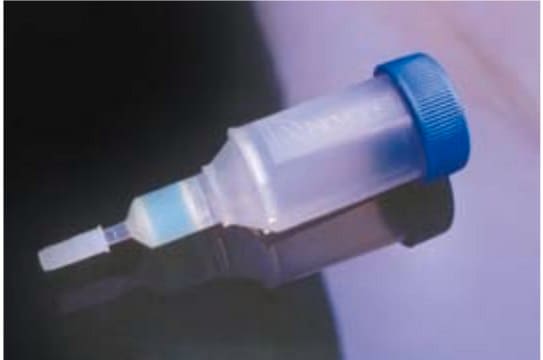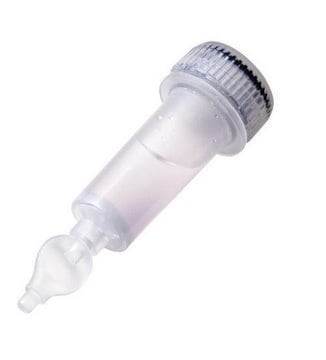For column chromatography, no more than 20 mM is suggested in the extract, equilibration, and wash buffers to prevent non-specific binding of proteins. No more than 250 mM is suggested for the elution buffers. Many proteins will elute with imidazole levels as low as 100 to 200 mM. For batch methods the imidazole concentration may have to be reduced or eliminated.When a protein is expressed at low levels, the presence of the imidazole limits the binding of the protein in the batch method but not when used in a column.
P6611
Gel d′affinité au nickel HIS-Select®
(1:1 suspension in a 20% ethanol solution)
Synonyme(s) :
Ni-NTA resin, nickel charged agarose
Sélectionner une taille de conditionnement
203,00 $
Sélectionner une taille de conditionnement
About This Item
203,00 $
Produits recommandés
Conjugué
magnetic beads
Niveau de qualité
Forme
(1:1 suspension in a 20% ethanol solution)
Caractéristiques
hydrophilic
Conditionnement
pkg of 1 mL
pkg of 100 mL
pkg of 25 mL
pkg of 5 mL
pkg of 500 mL
Concentration
1.5-2.4 mL/mL (suspension in packed gel)
Technique(s)
protein purification: suitable
Couleur
faint blue to very dark blue
Matrice
6% Beaded Agarose
Capacité
>15 mg/mL, gel binding capacity (protein)(with an approx. 30 kDa protein)
Température de transition
flash point 32 °C (closed cup)
Température de stockage
2-8°C
Description générale
Application
Caractéristiques et avantages
- Grande sélectivité, pour une plus grande pureté
- Liaison hydrophile non chargée inédite qui réduit l'adhésion non spécifique
- Capacité de fixation supérieure à 15 mg/ml pour les protéines marquées à l'histidine
- Fixation en conditions dénaturantes ou non dénaturantes
- Purification en une seule étape
- Interactions ioniques indésirables réduites au minimum
- Très faible élution du nickel
- Taille des billes : 45 à 165 μm
Liaison
Forme physique
Stockage et stabilité
Informations légales
Produit(s) apparenté(s)
Mention d'avertissement
Warning
Mentions de danger
Conseils de prudence
Classification des risques
Flam. Liq. 3
Code de la classe de stockage
3 - Flammable liquids
Classe de danger pour l'eau (WGK)
WGK 3
Point d'éclair (°F)
89.6 °F - closed cup
Point d'éclair (°C)
32 °C - closed cup
Faites votre choix parmi les versions les plus récentes :
Certificats d'analyse (COA)
Vous ne trouvez pas la bonne version ?
Si vous avez besoin d'une version particulière, vous pouvez rechercher un certificat spécifique par le numéro de lot.
Déjà en possession de ce produit ?
Retrouvez la documentation relative aux produits que vous avez récemment achetés dans la Bibliothèque de documents.
Les clients ont également consulté
Contenu apparenté
Techniques, réactifs et protocoles permettant de purifier les protéines recombinantes par différentes méthodes telles que la chromatographie d'échange d'ions, la chromatographie d'exclusion stérique ou la chromatographie d'affinité.
Protein purification techniques, reagents, and protocols for purifying recombinant proteins using methods including, ion-exchange, size-exclusion, and protein affinity chromatography.
Technologies d'expression protéique permettant d'exprimer des protéines recombinantes dans des systèmes d'expression de type E. coli, cellules d'insectes, levures et cellules de mammifères pour la recherche fondamentale et pour faciliter la production de médicaments et de vaccins.
Protein expression technologies for various expression systems supporting research, therapeutics, and vaccine production.
-
Can imidazole be used with HIS-Select® Nickel Affinity Gel, Product P6611?
1 answer-
Helpful?
-
-
Why won't my recombinant protein with a histidine-containing tag bind to HIS-Select® Nickel Affinity Gel, Product P6611?
1 answer-
Verify the pH and composition of sample and equilibration buffers. Make sure there are no chelating or reducing agents present in the extraction buffer. If using the batch mode, remove imidazole. Run the affinity purification under denaturing conditions. Run a Western blot of the extract to verify that the recombinant protein is present.
Helpful?
-
-
Can I use SDS with HIS-Select® Nickel Affinity Gel, Product P6611?
1 answer-
0.1% SDS has been used with some samples, with no adverse effects on the observed protein binding. However, SDS will effectively coat proteins and may block the binding to the column. It is probably very protein-specific and an SDS concentration that works for one protein may not work for another.
Helpful?
-
-
What needs to be done if the HIS-Select® Nickel Affinity Gel, Product P6611, resin turns brown on reuse?
1 answer-
During purification many protein extracts tend to discolor an affinity gel during the loading step. The original color will return after the wash or elution step. If the color is still not changing strip and recharge the affinity gel with nickel. Wash with EDTA and recharge with Nickel solution.
Helpful?
-
-
What is the Department of Transportation shipping information for this product?
1 answer-
Transportation information can be found in Section 14 of the product's (M)SDS.To access the shipping information for this material, use the link on the product detail page for the product.
Helpful?
-
-
Can Tris buffers be used instead of phosphate buffer for HIS-Select® Nickel Affinity Gel, Product P6611?
1 answer-
Yes, Tris buffers should work.
Helpful?
-
Active Filters
Notre équipe de scientifiques dispose d'une expérience dans tous les secteurs de la recherche, notamment en sciences de la vie, science des matériaux, synthèse chimique, chromatographie, analyse et dans de nombreux autres domaines..
Contacter notre Service technique









